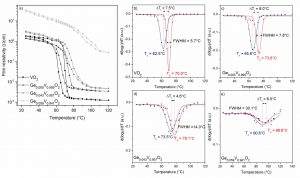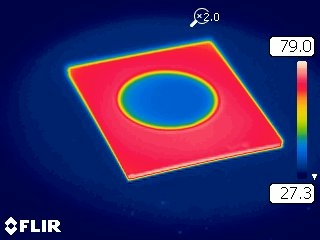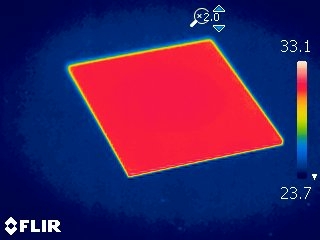Contact: Dr Andreas Schueler, Anna Krammer
Thermochromic vanadium dioxide films exhibit a reversible first-order phase transition from the semiconducting monoclinic to the tetragonal metallic phase at a temperature of 68°C. This thermochromic property makes these coatings useful for the overheating protection of solar thermal collectors.
It is well known that the transition temperature can be decreased by tungsten doping. We discovered that transition temperatures up to 95°C can be achieved by germanium doping of vanadium dioxide films (see Fig. 1). This discovery is interesting from a fundamental point of view and might help to clarify open question in the theoretical understanding of the semiconductor-to-metal transition. The complex electronic properties of these coatings is characterized by valence band and core level photoelectron spectroscopy (UPS & XPS). Scanning tunneling microscopy allows to probe the surface with nanometric resolution. The value of the band gap is determined for single nanometric crystallites by scanning tunneling spectroscopy (STS). Spectroscopic ellipsometry is a highly accurate method for determining the temperature-dependent dielectric function of the thermochromic coatings during the reversible transition from the semiconducting to the metallic phase. The size of the nanocrystals in the nanocomposite texture of the films is measured by X-ray diffraction (XRD), while the chemical composition can be inferred from Rutherford backscattering (RBS) or electron probe micro-analysis (EPMA). The information obtained by the various complementary techniques helps us to understand the fascinating physics of these novel thermochromic solar coatings.
In addition to the fascinating fundamental aspects of this solid-solid phase transition, there are useful applications. When such a film is deposited on an infrared-reflecting substrate, the thermal emissivity is low below the transition temperature, and high above the transition temperature (see Fig.2). Recently, we have achieved a decrease in αsol accompanied by an increase in εth for increasing temperature for the first time [KRA2022a]. This thermochromic property makes these coatings useful for the overheating protection of solar thermal collectors. Likewise, in the case of overheating of the solar thermal system in summer, the evaporation of the heat transfer liquid can be completely avoided, protecting the collector materials and simplifying the solar thermal installation.
The reversible metal-to-insulator transition of vanadium dioxide-based materials is also of considerable interest in microelectronics. In collaboration with EPFL/NANOLAB (Prof. Adrian Ionescu) we contribute to the development of a multitude of VO2 based microelectronic devices, including Peano reconfigurable inductors [MUL2019], reconfigurable split ring resonator microwave filters, RF tunable phase shifters, tunable planar waveguide filters, Van der Waals MoS2/VO2 heterostructures for tunable rectifiers [OLI2017], photodiodes and field effect transistors, phase-change steep-slope and tunnel field-effect transistors [VIT2017].
In collaboration with EPFL/POWERLAB (Prof. Elison Matioli) we study electronically accessible long-lived structural states in vanadium dioxide that can provide a scheme for data storage and processing. These glass-like functional devices could outperform conventional metal-oxide-semiconductor electronics in terms of speed, energy consumption and miniaturization, as well as provide a route to neuromorphic computation and multilevel memories [NIK2022].

Fig. 1:
a) Temperature dependent electrical resistivity of VO2 and GexV(1-x)O2 films on Si (100) substrate. The transition temperature is progressively increasing with the Ge content.
b)-e) The d(log ρ)/dT vs T curves are plotted for all samples. Measured data points (symbols) are fitted with Gaussian functions (lines) whose minima denote the transition temperatures upon heating, Th and cooling, Tc. The difference between Th – Tc gives the hysteresis width ΔTt, while the FWHM determines the sharpness of the semiconductor-t-metal transition [KRA2017].


Fig. 2: Infrared imaging of the thermochromic behaviour of an inorganic thin film. Above the transition temperature, the film shows metallic behaviour and is opaque (image on the left). Below the transition temperature, the film is semiconducting and therefore IR – transparent (image on the right).
PhD Theses in this domain:
A. Krammer, Doping of thermochromic oxide coatings for overheating protection of solar thermal collectors, EPFL PhD thesis No. 7625 (2020), thesis director Prof. J.-L. Scartezzini, codirector A. Schüler
A. Paone, Switchable Selective Absorber Coatings for Overheating Protection of Solar Thermal Collectors, EPFL PhD Thesis No. 5878 (2013), thesis director Prof. J.-L. Scartezzini, codirector A. Schüler
Selected references
[KRA2022a] Krammer, A., Matilainen, A., Pischow, K., Schüler, A., VO2:Ge based thermochromic solar absorber coatings, Solar Energy Materials and Solar Cells, 2022, 240, 111680. https://doi.org/10.1016/j.solmat.2022.111680
[KRA2022b] Krammer, A., Lagier, M., Schüler, A., In-line electronic and structural characterization of reactively sputtered Cu-Co-Mn black spinel oxides, Journal of Vacuum Science and Technology A: Vacuum, Surfaces and Films, 2021, 39(5), 053411. https://doi.org/10.1116/6.0001120
[KRA2017] Krammer, A., Magrez, A., Vitale, W.A., Mocny, P., Jeanneret, P., Guibert, E., Whitlow, H.J., Ionescu, A.M., Schüler, A., Elevated transition temperature in Ge doped VO2 thin films, (2017) Journal of Applied Physics, 122 (4), art. no. 045304.
https://doi.org/10.1063/1.4995965
[MUL2019] Müller A.A., Moldoveanu A., Asavei V., Khadar R.A., Sanabria-Codesal E., Krammer A., Fernandez-Bolaños M., Cavalieri M., Zhang J., Casu E., Schüler A., Ionescu A.M. (2019). 3D Smith charts scattering parameters frequency-dependent orientation analysis and complex-scalar multi-parameter characterization applied to Peano reconfigurable vanadium dioxide inductors. Scientific Reports, 9 (1), 18346. DOI: https://doi.org/10.1038/s41598-019-54600-5
[NIK2022] Nikoo, M.S., Reza Soleimanzadeh, R., Krammer, A., Marega, G.M., Yunkyu Park, Y., Son, J., Schueler, A., Andras Kis, A., Moll, P.J.W., Matioli, E., Electrical control of glass-like dynamics in vanadium dioxide for data storage and processing, Nature Elecronics, 2022, Vol. 5, 96–603
https://doi.org/10.1038/s41928-022-00812-z
[OLI2017] Oliva N., Casu E.A., Yan C., Krammer A., Rosca T., Magrez A., Stolichnov I., Schueler A., Martin O.J.F., Ionescu A.M. (2017). Van der Waals MoS2/VO2 heterostructure junction with tunable rectifier behavior and efficient photoresponse. Scientific Reports, 7 (1), 14250. https://doi.org/10.1038/s41598-017-12950-y
[PAO2015a] Paone A., Sanjines R., Jeanneret P., Whitlow H.J., Guibert E., Guibert G., Bussy F., Scartezzini J.-L., Schüler A. (2015a). Influence of doping in thermochromic V1-xWxO2 and V1-xAl xO2 thin films: Twice improved doping efficiency in V1-xWxO2. Journal of Alloys and Compounds 621, 206–211. https://doi.org/10.1016/j.jallcom.2014.08.264
[PAO2015b] Paone A., Sanjines R., Jeanneret P., Schüler A. (2015). Temperature-dependent multiangle FTIR NIR-MIR ellipsometry of thermochromic VO2 and V1-xWxO2 films. Solar Energy 118, 107-116. https://doi.org/10.1016/j.solener.2015.05.020
[VIT2017] Vitale W.A., Casu E.A., Biswas A., Rosca T., Alper C., Krammer A., Luong G.V., Zhao Q.-T., Mantl S., Schüler A., Ionescu A.M. (2017). A Steep-Slope Transistor Combining Phase-Change and Band-to-Band-Tunneling to Achieve a sub-Unity Body Factor. Scientific Reports, 7 (1), 355. https://doi.org/10.1038/s41598-017-00359-6